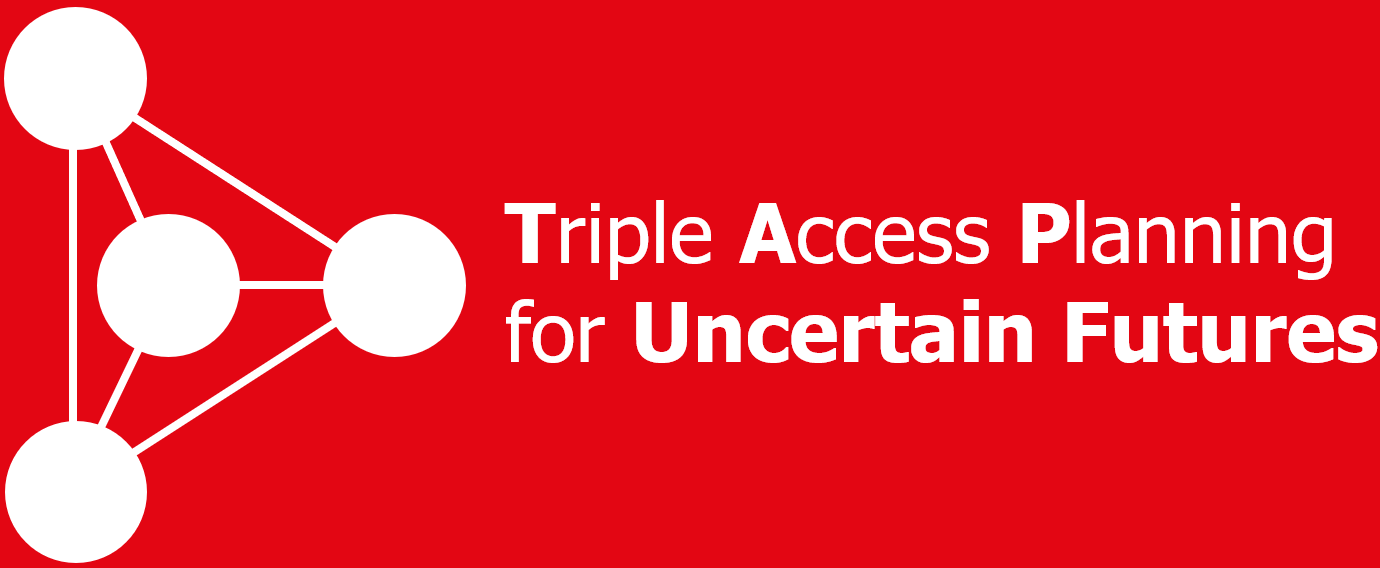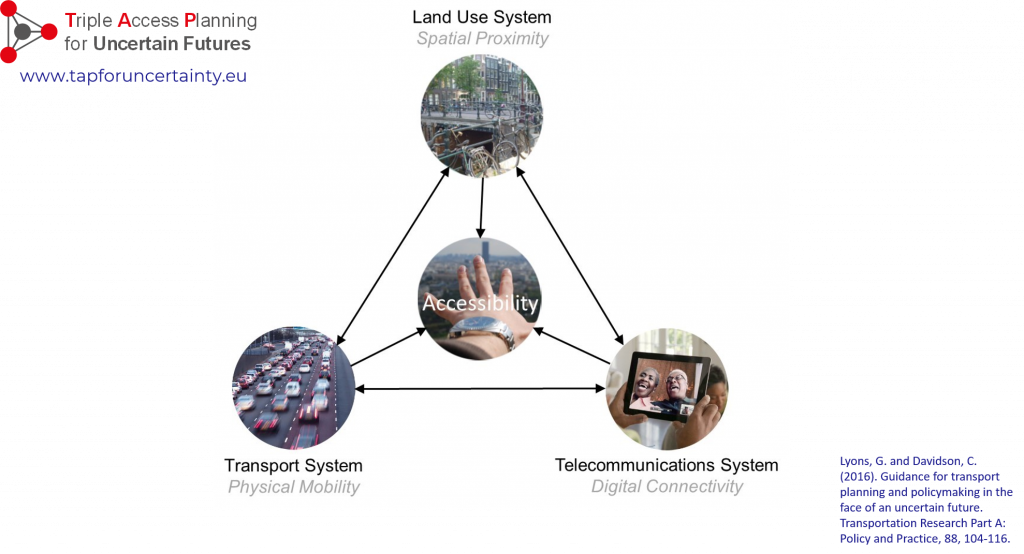Introduction by Stephen Cragg
An outsider’s perspective on complex projects
Developing and then looking to deliver a plan to shape the future of urban mobility is a complex business. Imagine adding to that the need to consider how the transport system, land use system and telecommunications systems interact to affect how we go about our daily lives, coupled with a need to come to terms with uncertainty over how that ‘triple access system’ could or should change. I’m part of the pan-European project ‘Triple Access Planning for Uncertain Futures’ which is looking at getting to grips with this. It’s complex! And when you are inside such a project it can become difficult to see the wood for the trees sometimes. In this blog, Glenn Lyons and I come together to highlight how an outsider’s perspective can be helpful.
The complex case of Triple Access Planning
Expectations of Sustainable Urban Mobility Plans (SUMPs) are now considerable in the face of the climate emergency and a society in a pronounced state of flux. The conceptual case for taking a ‘Triple Access Planning’ (TAP) approach to developing and delivering SUMPs is appealing. TAP encourages a recognition that sustainable urban mobility is a product not only of how we travel but of the spatial layout of origins and destinations and – increasingly, it can be argued – a product of how digital accessibility is affecting whether we need to travel at all to meet some of our needs to access people, goods, employment, services and opportunities. TAP also seeks to explore and accommodate rather than conceal uncertainty.
We cannot expect that it will be easy to develop and deliver a SUMP that embodies TAP. It is a complex, multi-faceted proposition for intervention which is very likely to involve many different individual measures and projects being developed in semi-isolation then brought together to ‘deliver the plan’. This is not, in itself, an unusual problem. Any major complex intervention (e.g. building a new bridge) involves many sub-elements which in turn can create more sub-sub-elements, etc.
Where it gets more challenging is when the projects are not focused on a single outcome, are not within the remit of one organisation, impact on thousands or even millions of people, are being developed at different times, in an ever-shifting policy environment and against a backdrop of ever-increasing uncertainty but also the urgency of the climate emergency.
We need to ‘hit the ground running’ in transforming how we deliver sustainable travel. To do that we should not only look at what successes have happened but also at what has failed or at least could have been done better.
The complex case of the Strategic Transport Projects Review
Glenn and I are both heavily involved in the Triple Access Planning for Uncertain Futures project. We approach it from different perspectives but both from inside the project. Meanwhile, away from this project, I have also been involved in another complex and much bigger project: the second Strategic Transport Projects Review (STPR2). In 2020, the Scottish Government published its second National Transport Strategy. This set out a vision with accompanying priorities and outcomes for Scotland’s transport system. To achieve this vision the strategy has an associated delivery plan with a large number of actions. One of these actions was a major study to determine what transport infrastructure is needed over the next 20 years. The final report of this STPR2 study was published in December 2022.
It is very difficult to do an introspective review of your own work, so I was delighted when Glenn did a review of the final report from an outsiders’ perspective.
Over to Glenn.
The outsider’s perspective by Glenn Lyons
Providing an outsider’s perspective as a form of CPD
I’ve developed a bit of a thing for voluntarily making the time to review significant new reports that come out – particularly those from national bodies that relate to transport planning, policy and appraisal. Don’t get me wrong, it’s not a regular habit because time simply doesn’t allow for that. What I’ve realised is that this can be a rather productive form of Continuing Professional Development (CPD) – I decide to read a report; it then seems sensible to make some notes while I do so; and it then seems worthwhile to go a little further and turn those notes into a short article that captures what struck me in reviewing the report. Such a discipline means I pay closer attention when reading a report. It also means I then have to think about how to articulate my review commentary in a constructive and accessible way. If I manage all that then my review (usually written as a LinkedIn blog) can be helpful to others wanting an insight into the report in question.
So – I decided to review STPR2 and wrote a LinkedIn article about it.
Issues that can come to light when you’re on the outside looking in
I don’t propose here to try and explain STPR2 and go into detail on it. What I want to do is highlight the sort of things when looking in from the outside it might be helpful for those on the inside to be aware of.
What is it? When you have been on the inside of a project for a long time you start to take for granted that you (hopefully) ‘get it’ and know (fairly well) where it fits in within the bigger picture. But the bigger picture can be complicated with other documents that inter-relate in ways you don’t understand from the outside looking in. You can feel bamboozled by acronyms and assumed prior knowledge you don’t have. In order to begin offering constructively critical commentary on something you need to have a reasonable understanding in the first place of what it’s all about and what was involved.
What’s excluded? Often a report presents the polished version of what made it past the cutting room floor into the final edit. One is presented with what was in scope and judged as important. In my view, however, what didn’t make the cut and why can make for important further insight, especially when trying to understand the overall initiative. Similarly it is not always helpful to be presented with examples of best/good practice unless accompanied by examples of worst/poor practice.
What’s hidden? Earlier in my career I didn’t fully appreciate the importance of an executive summary to a document or even a summary report to accompany the full report. The realisation that busy senior people might never ever open the full report is sobering. What then matters is that the summary does indeed encapsulate the most important aspects of the full report. This is a matter of judgement. If you dig deeper than the summary you may find that there is material you, as the reader, consider especially important, that never got a mention in the summary.
How come? Another product of an ‘inside job’ when it comes to writing a report is that certain matters can be taken for granted and not mentioned or explained. There may be lists and tables indicating a summary of relative importance or ratings but without the ability for the reader to make sense of the ‘why?’ behind them. Without the ‘why?’ being addressed in their mind, the reader learns less and goes away with what may be inadequate understanding or even confusion. And outsider can readily ask the ‘why?’ questions if invited to do so and help test whether the authors are meeting the needs of the readers.
What else? Within a project there can be a diversity of perspectives and this is how it should ideally be, especially when dealing with wicked problems. Yet over time those perspectives may become somewhat conditioned to the nature of the project, the process involved and the rounds of dialogue that have taken place. An outsider has the mixed blessing of on the one hand having less understanding about the inner workings of the project and on the other hand having….well…less understanding about the inner workings of the project.A fresh perspective can lead to new questions being prompted: so what?; so why?; so how? so what next? so what if? There comes a point where the questions must end and the report must be finished, but it can be well worth giving an outsider’s questions an airing.
Perhaps it seems obvious to observe such things as those above but sometimes when you’ve been inside for long enough it gets lost, especially in a complex project. Of course, being a reviewer of someone else’s work and offering commentary on such questions above then comes around to the question of ‘do you practice what you preach?’ when I look to what Stephen and I are up to with our partners on the inside of the Triple Access Planning for Uncertain Futures project. We do engage with others and have sought to get outsiders’ perspectives. In fact we’ve even developed a serious game to help us to do so. Nevertheless, we can and should look to do more. So – if you feel at any point minded to offer us an outsider’s view on the project, we’d love to have your questions to be able to reflect upon how we might further up our game.

